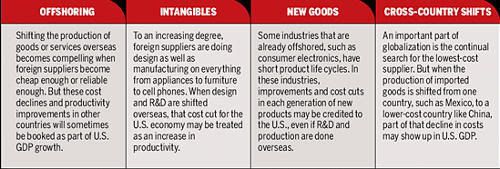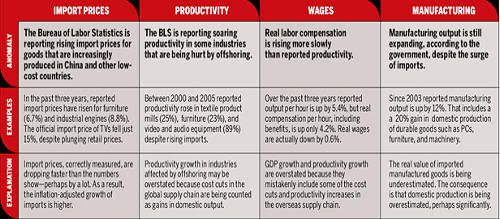♠ Posted by Emmanuel in Anti-Globalization,Trade
at 6/16/2007 03:09:00 AM
A recent series of articles [1, 2, 3, 4] in BusinessWeek by Michael Mandel claims that US GDP has been overstated by a whopping $66 billion since 2003. According to BW, accounting by the Bureau of Economic Analysis fails to consider the effects of offshoring on domestic manufacturing through a variety of ways as illustrated here:
A more detailed breakdown is offered as well on how these factors purportedly show up in the figures recorded by the BEA as seen in selected anomalies:
The basic story offered by BW is that production figures are being skewed for the BEA has not fully considered the effects of offshoring:
The short explanation is that the growth of domestic manufacturing has been substantially overstated in recent years. That means productivity gains and overall economic growth have been overstated as well. And that raises questions about U.S. competitiveness and "helps explain why wage growth for most American workers has been weak," says Susan N. Houseman, an economist at the W.E. Upjohn Institute for Employment Research who identifies the distorting effects of offshoring in a soon-to-be-published paper.However, the BEA retorts that these claims are exaggerated for the agency is not as slovenly in its methods as portrayed by Mandel:
The underlying problem is located in an obscure statistic: the import price data published monthly by the Bureau of Labor Statistics (BLS). Because of it, many of the cost cuts and product innovations being made overseas by global companies and foreign suppliers aren't being counted properly. And that spells trouble because, surprisingly, the government uses the erroneous import price data directly and indirectly as part of its calculation for many other major economic statistics, including productivity, the output of the manufacturing sector, and real gross domestic product (GDP), which is supposed to be the inflation-adjusted value of all the goods and services produced inside the U.S.
The result? BusinessWeek's analysis of the import price data reveals offshoring to low-cost countries is in fact creating "phantom GDP"--reported gains in GDP that don't correspond to any actual domestic production. The only question is the magnitude of the disconnect. "There's something real here, but we don't know how much," says J. Steven Landefeld, director of the Bureau of Economic Analysis (BEA), which puts together the GDP figures. Adds Matthew J. Slaughter, an economist at the Amos Tuck School of Business at Dartmouth College who until last February was on President George W. Bush's Council of Economic Advisers: "There are potentially big implications. I worry about how pervasive this is."
By BusinessWeek's admittedly rough estimate, offshoring may have created about $66 billion in phantom GDP gains since 2003 (page 31). That would lower real GDP today by about half of 1%, which is substantial but not huge. But put another way, $66 billion would wipe out as much as 40% of the gains in manufacturing output over the same period...
Depending on your attitude toward offshoring, the existence of phantom GDP is either testimony to the power of globalization or confirmation of long-held fears. The U.S. economy no longer stops at the water's edge. Global corporations often provide their foreign suppliers and overseas subsidiaries with business knowledge, management practices, training, and all sorts of other intangible exports not picked up in the government data. In return, they get back cheap products...
More broadly, it becomes clear that "gains from trade are being measured instead of productivity," according to Robert C. Feenstra, an economist at the University of California at Davis and the director of the international trade and investment program at the National Bureau of Economic Research. "This has been missed."
Pat Byrne, the global managing partner of Accenture Ltd.'s (ACN ) supply-chain management practice, goes even further, suggesting that "at least half of U.S. productivity [growth] has been because of globalization." But quantifying this is tough, he notes, because most companies don't look at how much of their productivity growth is onshore and how much is offshore. "I don't know of any companies or industries that have tried to measure this. Maybe they don't even want to know."
Phantom GDP helps explain why U.S. workers aren't benefiting more as their companies grow ever more efficient. The cost savings that companies are reaping "don't represent increased productivity of American workers producing goods and services in the U.S.," says Houseman. In contrast, compensation of senior executives is typically tied to profits, which have soared alongside offshoring...
The import price index also misses the cost cut when production of an item, such as blue jeans, is switched from a country such as Mexico to a cheaper country like China. That's especially likely to happen if the item goes through a different importer when it comes from a new country, because government statisticians have no way of linking the blue jeans made in China with the same pair that had been made in Mexico.
Phantom GDP can also be created in import-dependent industries with fast product cycles, because the import price statistics can't keep up with the rapid pace of change. And it can happen when foreign suppliers take on tasks such as product design without raising the price. That's an effective cost cut for the American purchaser, but the folks at the BLS have no way of picking it up.The effects of phantom GDP seem to be mostly concentrated in the past three years, when offshoring has accelerated. Indeed, the first time the term appeared in BusinessWeek was in 2003. Before then, China and India in particular were much smaller exporters to the U.S.
A recent set of articles in BusinessWeek suggests that the real cost of offshoring has been understated because there is a “flaw” in the way that price statistics treat offshoring and that, as a result, real GDP and productivity growth are actually less robust than official statistics indicate. However, analysts at BEA—who are continuously updating the official estimates to reflect the impact of globalization—do not think that there is a significant bias on measured GDP or productivity growth.Hu's right and who's wrong [sorry for the pun on Chinese premier Hu Jintao]? I too have gripes about BEA data, but all the same, I have serious conceptual problems with these "new economy"-type arguments that offshoring/outsourcing/globalization have rendered national statistical data collection as we know it obsolete. Still, it's food for thought and presents ammunition for the globalization-is-evil crowd whose numbers are legion.
The argument made in the articles hinges on the fact that the import price data—published by the Bureau of Labor Statistics and used by BEA to “deflate” or convert nominal imports to real imports—do not reflect the full cost saving when foreign suppliers are substituted for domestic suppliers. However, import price indexes are designed to measure the change over time in the prices paid by U.S. residents for imported goods and services; they do not directly compare the prices of imported goods (and services) to their counterparts produced in the United States.
This is a manifestation of an old and difficult problem in price measurement. The argument fails to recognize that an offset occurs when domestic goods and services are purchased in the United States. That is, if real imports are understated because shifts to foreign suppliers are not being adequately captured in the price data, it is also likely that domestic production is understated because of shifts to more efficient domestic suppliers. Furthermore, BEA uses chain-type measures that are designed to account for much of this substitution. Any remaining measurement errors should be offsetting because researchers have not demonstrated that errors in measuring imports are larger than offsetting errors in measuring domestic production.
There is no clear “fix” for the price measurement problem beyond the adoption of chained-dollar estimates to measure real GDP, which BEA adopted in 1996. Nominal, or current-dollar, GDP is not affected because the amount deducted from nominal GDP for imports represents the actual amount spent for imports. Further, there are no distortions in the nominal trade balance, or other nominal measures, such as corporate profits and wages and salaries.


